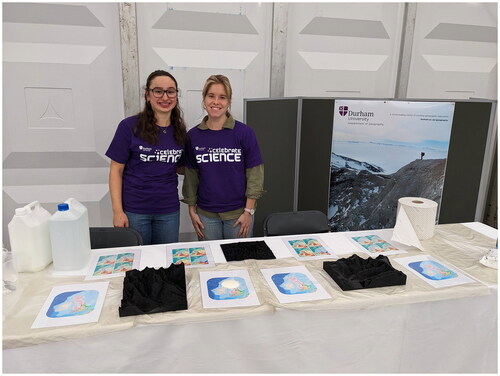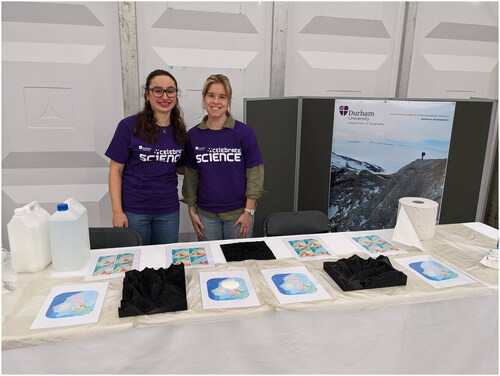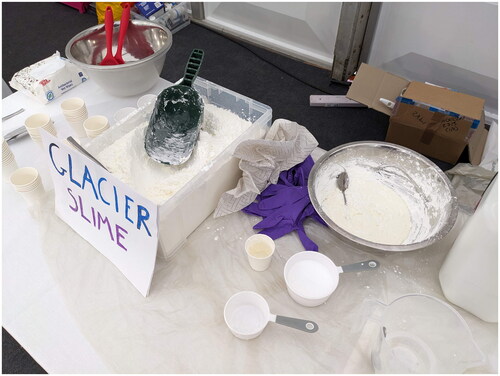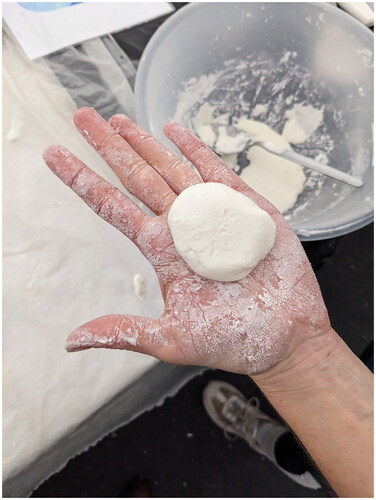Abstract
A material commonly known as Flubber, with properties that are excellent for teaching about glaciers, has been widely used in geosciences education. Yet, the original recipe contains borax, which has health risks that should be avoided. A new recipe is shared containing low-cost, readily available ingredients that produces a reformulated Flubber with properties similar to the original without the associated health risks.
A material commonly called “Flubber” has been used in education settings to explore the flow of glaciers for at least two decades. It is also used in a variety of educational settings as a hands-on physical science, chemistry, and materials science activity. Flubber is classified as a gel because it exhibits properties of both solids and liquids. These properties, and the cheap and easily available components, have made it popular with geoscience educators. In education and outreach activities at the Byrd Polar and Climate Research Center (Byrd Center), Flubber simulates glacier flows, and children are encouraged to explore how it flows and describe the structures that it forms.
Background and uses
Traditionally, Flubber is composed of liquid polyvinyl acetate (PVA or Elmer’s glue) diluted with water mixed with borax. Borax (chemical name: sodium tetraborate decahydrate) is sold to consumers in the United States as 20 Mule Team between 60 to 100% concentration, with the exact concentration withheld as a trade secret (Education Innovations 2018). In education settings, youth are often given the water, glue, and borax to mix with their hands without any personal protective gear.
In the early 2000s when Jason Cervenec began teaching high school science, Flubber was used in physical science and chemistry classes, and the local science center had a recipe that was widely shared. When Cervenec began as the outreach coordinator at the Byrd Center, Flubber was often used at science festivals, for school visits, and with take-home kits. Flubber remains a popular material recommended by education and outreach professionals to simulate glacier flow (Campbell and Williams Citationn.d.; EarthScope Consortium Citation2019; Ice Drilling Program Education and Outreach Citationn.d.; National Park Service Citation2017; UCAR: Center for Science Education Citationn.d.; UMaine Cooperative Extension/4-H Citation2016).
Safety concerns
Recent health data supports using an alternative to borax in recipes for Flubber. Banned as a food additive in most developed countries, borax has also been banned for general sale in the European Union and United Kingdom since 2010 (European Chemicals Agency Citation2010; European Chemicals Agency Citation2015). Additionally, a Canadian health advisory recommends that pregnant women and children avoid the substance (Government of Canada Citation2016). Even in countries without specific regulatory concerns surrounding borax exposure, educators may wish to apply the precautionary principle toward borax exposure.
The material safety data sheet (MSDS) indicates that borax should not be used with youth, especially audiences that might consume the materials. Borax causes skin, digestive, and respiratory system irritation; causes serious eye irritation; and may be fatal if swallowed. It is also suspected of affecting the health of unborn children and fertility in humans. This information is readily available on the MSDS for common consumer-grade versions of borax, 20 Mule Team available from Educational Innovations (Citation2018), and a reagent-grade version from Fisher Scientific (Citation2008).
Reformulation
Due to the above concerns, we worked to find an alternative to the Flubber recipe. Another material commonly used in education, called Oobleck, is made with cornstarch (referred to as corn flour outside North America) and water. However, the team wanted to recreate the texture and flow of the borax-based Flubber recipe while mitigating the unusual property of Oobleck—a non-Newtonian solid—to rapidly harden when struck. Our target objectives were a material that
most closely replicated the characteristics of borax-based Flubber;
was cheap to produce, without the need for hard-to-obtain ingredients; and
was relatively easy to clean up.
Following a series of trials, the following formulation was found to be an acceptable substitute as
ongoing hardening of the material over approximately one hour increased the ease of cleanup from surfaces and
although the non-Newtonian properties of the material is not perfectly accurate to glacier behavior, it provided sufficient opportunities for exploration of the nature of glacier ice behavior (referred to as a visco-elastic properties) over both short-term (e.g., fracture, iceberg calving, and crevassing over scales of seconds to hours) and long-term (e.g., ice flow over years to decades) timescales.
Flubber Recipe
Composition by volume:
1 part water
1 part polyvinyl acetate (PVA) glue (i.e., Elmer’s glue)
3 parts cornstarch (corn flour in the UK)
*For one child or a small group, ¼ cup water, ¼ cup PVA glue, and ¾ cup cornstarch produce a sufficient volume.
Procedure:
Add the water and glue to a large container and mix the two ingredients with a spoon. Once the glue and water are well mixed, add the cornstarch a little at a time while mixing. Adding the cornstarch gradually will ensure that it is mixed uniformly and avoid clumping. Continue to mix until a ball can be formed from the substance. If the correct texture is reached, the ball should then flow slowly when placed on a flat surface. If the Flubber flows too quickly, add more cornstarch until the desired consistency is reached. This video demonstrates the process.
Value of consulting MSDS sheets and final safety thoughts
There has been a longstanding practice in chemistry education to consult MSDS before laboratory demonstrations or activities to review safe use, cleanup, and disposal.
The team’s experience with the original Flubber formulation reminds us that MSDS should be reviewed for all ingredients, regardless of their longstanding use. Likewise, personal protective gear, including goggles, should always be worn. In the case of borax, gloves, masks, and mandatory hand washing are also advisable when the material has been directly handled. Furthermore, students should never be allowed to bring materials home with them to keep them safe and to limit exposure to siblings and pets. While adults are more likely to mitigate their exposure, there is a risk of repeated exposure over multiple classes/sessions.
There is sufficient evidence to suggest that borax should not be used for youth activities, and safety protocols should be followed when it is used in other settings. Instead, use some cornstarch for your next round of glacier flow activities. Additional chemical safety training for teachers—including personal protective gear, storage, and classroom use—is available online at no cost via the American Chemical Society ACS Institute’s Foundations of Chemical Safety and Risk Management (Citation2023) and the American Association of Chemistry Teachers Safety Resources (Citation2023). Local universities and community colleges might also offer training and serve as a resource. Furthermore, Miller, Heideman, and Greenbowe (Citation2000) articulate components of a chemical hygiene and safety program, including MSDS, that was integrated into the undergraduate chemistry curriculum at the University of Iowa to teach students appropriate safety measures as well as involve them in enforcement of safety practices.
Photo 1. Flubber placed on a 3D-printed model of a mountain landscape flows downhill, analogous to how glaciers flow.
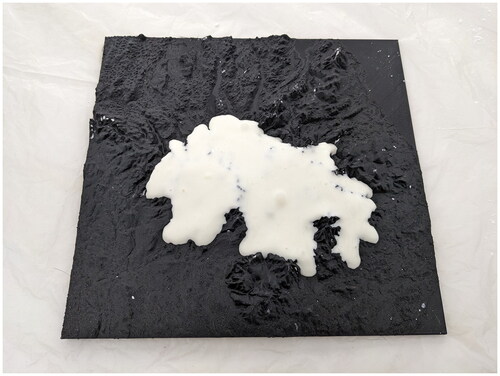
Photos 2 and 3. Beyond classroom use, Flubber serves as a great hands-on activity for after-school programs and community science events, as shown here at Durham University. Youth made their own Flubber, referred to as Glacier Slime, and were able to place it on a few landscapes to explore.
Acknowledgments
Thank you to Ted Clark who offered feedback on early drafts of this article; Naomi Chapman for suggesting further replacement recipes; intern Nathaniel Browning for helping us fine-tune our new Flubber recipe; and Penny Claire, Amy Baxter, and Ellery Littlewood for assisting with the Durham Celebrate Science Festival shown in this article.
References
- American Association of Chemistry Teachers. 2023. Safety Resources. https://teachchemistry.org/classroom-resources/safety
- American Chemical Society. 2023. ACS Institute Foundations of Chemical Safety and Risk Management. https://institute.acs.org/courses/foundations-chemical-safety.html
- Campbell, S., and K. Williams. n.d. Glacier Flow Predictive Modeling via Flubber. https://www.polartrec.com/resources/lesson/glacier-flow-predictive-modeling-flubber
- EarthScope Consortium. 2019. Science with Flubber: Glacial Isostasy. Last updated December 24. 2019. https://www.unavco.org/education/outreach/demonstrations/science-with-flubber-glaciers/science-with-flubber-glaciers.html
- Educational Innovations. 2018. MSDS Sheet for 20 Mule Team Borax. https://cdn.commercev3.net/cdn.teachersource.com/downloads/MSDS/Borax-SDS.pdf
- European Chemicals Agency. 2010. Member state committee draft support document for identification of disodium tetraborate, anhydrous as a substance of very high concern because of its CMR properties. Adopted on June 9, 2010.
- European Chemicals Agency. 2015. Recommendations for inclusion in the Authorisation List. https://echa.europa.eu/recommendations-for-inclusion-in-the-authorisation-list/-/dislist/details/0b0236e1804df5f2
- Fisher Scientific. 2008. MSDS Sheet for Sodium tetraborate decahydrate. https://fscimage.fishersci.com/msds/21010.htm
- Government of Canada. 2016. Information Update - Health Canada advises Canadians to avoid homemade craft and pesticide recipes using boric acid. https://recalls-rappels.canada.ca/en/alert-recall/information-update-health-canada-advises-canadians-avoid-homemade-craft-and-pesticide
- Ice Drilling Program Education and Outreach. n.d. Slip Sliding Away: Exploring glacier dynamics. https://icedrill-education.org/portfolio/slip-sliding-away-exploring-glacier-dynamics/
- Miller, G.J., S.A. Heideman, and T.J. Greenbowe. 2000. Introducing proper chemical hygiene and safety in the general chemistry curriculum. Journal of Chemical Education 77 (9): 1185.
- National Park Service. 2017. Flubber Glacier Model. Last updated June 19, 2017. https://www.nps.gov/subjects/geology/learnflubberglacier.htm
- UCAR: Center for Science Education. n.d. Model a Moving Glacier. https://scied.ucar.edu/activity/model-moving-glacier
- UMaine Cooperative Extension/4-H. 2016. Use Flubber to Model Ice Shelf-Glacier Interactions and Sea Level Rise. On Science Friday on September 23, 2016. https://www.sciencefriday.com/wp-content/uploads/2016/09/Ice-Shelf-Flubber-Activity-FAR-2016.pdf


